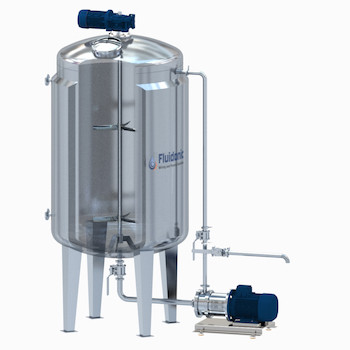-
Ingredient Preparation:
- Gather all the necessary ingredients, including fresh milk, flavorings (such as vanilla, chocolate, or other desired flavors), sweeteners, and any additional components required for the specific milk product.
-
Jacketed Process Tank:
- Transfer the fresh milk into a jacketed process tank equipped with a heating/cooling system.
- The jacketed tank helps control the temperature of the milk during processing.
-
Heating (Optional):
- If necessary, heat the milk in the jacketed tank to enhance the solubility of flavorings and other ingredients. Heating can also aid in the homogenization process.
-
Addition of Flavorings and Ingredients:
- Introduce the flavorings and other ingredients into the jacketed process tank.
- Ensure uniform distribution of flavorings by gentle agitation or stirring.
-
Inline Homogenizer:
- Implement an inline homogenizer into the processing line after the initial flavor addition in the process tank.
- The inline homogenizer will further disperse and blend the flavorings throughout the milk, creating a smooth and homogeneous mixture.
-
Homogenization with Inline Homogenizer:
- Activate the inline homogenizer to apply high shear forces to the milk mixture.
- The homogenizer breaks down fat globules, reduces particle sizes, and ensures a fine and consistent dispersion of flavorings in the milk.
-
Cooling (if necessary):
- If the process involves heating, allow the flavored milk mixture to cool using the cooling function of the jacketed tank or other cooling mechanisms.
-
Adjustments and Quality Checks:
- Conduct quality checks to ensure that the flavoring is evenly distributed and that the milk has the desired taste and texture.
- Make any necessary adjustments to flavor intensity or other parameters.
-
Pasteurization (Optional):
- If required, pasteurize the flavored milk to ensure safety and extend shelf life. This step involves heating the milk to a specific temperature and holding it for a set time before cooling.
-
Packaging or Further Processing:
- Transfer the flavored and homogenized milk to the packaging stage or proceed with additional processing steps, such as adding fortifications, stabilizers, or adjusting the fat content.
-
Clean-In-Place (CIP) Process:
- Implement a thorough cleaning process, especially for the homogenizer and process tanks, using a CIP system to prepare the equipment for subsequent batches or other processes.
Notes:
-
Homogenization for Texture:
- The homogenization step not only disperses flavorings but also contributes to a smoother texture and prevents cream separation in milk.
-
Temperature Control:
- Controlling the temperature during the process helps achieve optimal solubility of flavorings and ensures efficient homogenization.
- Flexibility in Flavors:
- This process is versatile and can be adapted for various flavored milk products by adjusting the types and quantities of flavorings used.
-
Consistency and Quality:
- The combination of a process tank and inline homogenizer ensures consistent quality and flavor distribution, essential for commercial production.
- Consideration of Product Characteristics:
- Adjust the process parameters based on the specific characteristics of the milk product being produced, considering factors like fat content and desired mouthfeel.
By integrating an inline homogenizer with process tanks, this flavoring process ensures that the flavorings are thoroughly and uniformly incorporated into the milk, resulting in a high-quality, flavored milk product.
